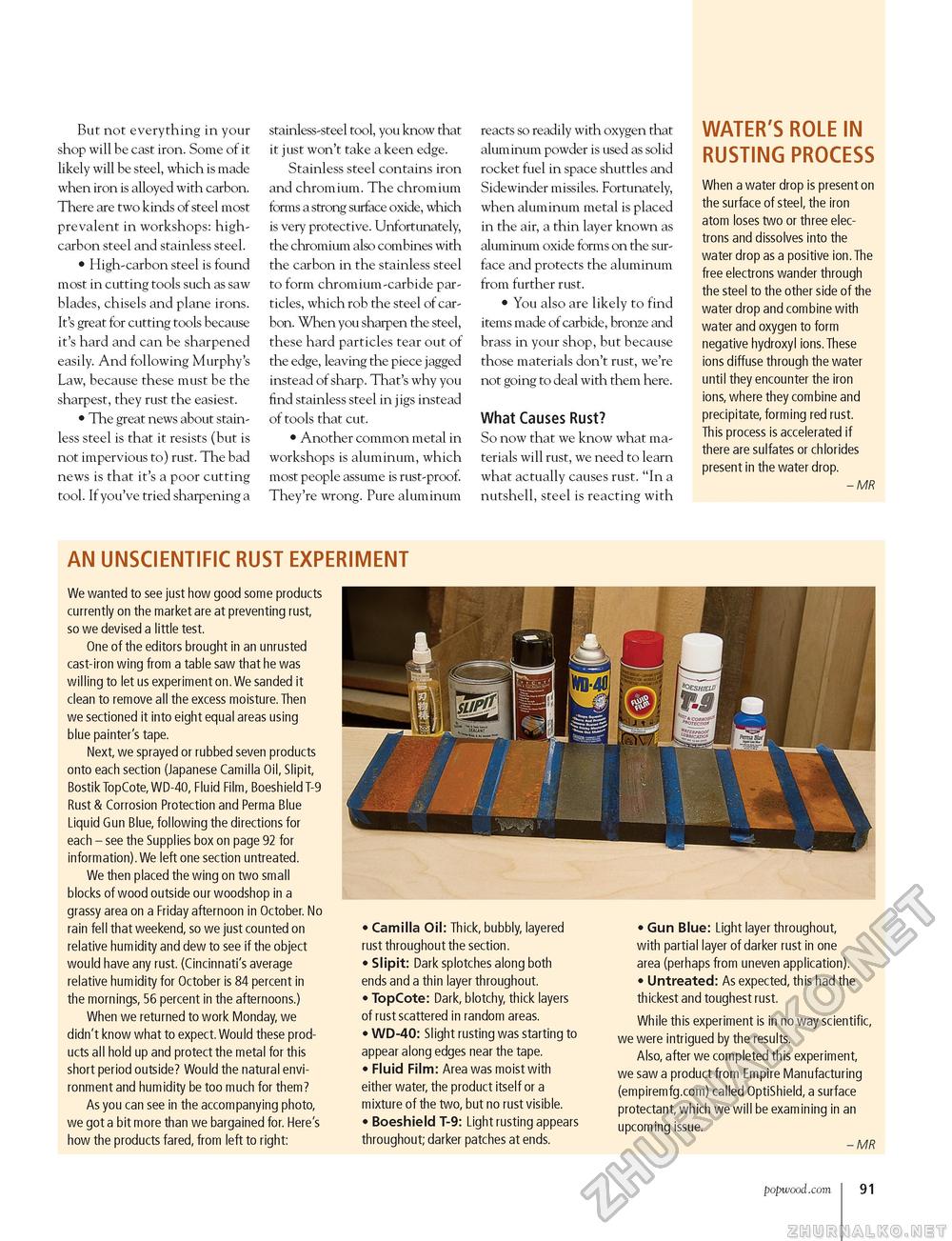Popular Woodworking 2004-04 № 140, страница 94
But not everything in your shop will be cast iron. Some of it likely will be steel, which is made when iron is alloyed with carbon. There are two kinds of steel most prevalent in workshops: high-carbon steel and stainless steel. • High-carbon steel is found most in cutting tools such as saw blades, chisels and plane irons. It's great for cutting tools because it's hard and can be sharpened easily. And following Murphy's Law, because these must be the sharpest, they rust the easiest. • The great news about stainless steel is that it resists (but is not impervious to) rust. The bad news is that it's a poor cutting tool. If you've tried sharpening a stainless-steel tool, you know that it just won't take a keen edge. Stainless steel contains iron and chromium. The chromium forms a strong surface oxide, which is very protective. Unfortunately, the chromium also combines with the carbon in the stainless steel to form chromium-carbide particles, which rob the steel of carbon. When you sharpen the steel, these hard particles tear out of the edge, leaving the piece jagged instead of sharp. That's why you find stainless steel in jigs instead of tools that cut. • Another common metal in workshops is aluminum, which most people assume is rust-proof. They're wrong. Pure aluminum reacts so readily with oxygen that aluminum powder is used as solid rocket fuel in space shuttles and Sidewinder missiles. Fortunately, when aluminum metal is placed in the air, a thin layer known as aluminum oxide forms on the surface and protects the aluminum from further rust. • You also are likely to find items made of carbide, bronze and brass in your shop, but because those materials don't rust, we're not going to deal with them here. What Causes Rust? So now that we know what materials will rust, we need to learn what actually causes rust. "In a nutshell, steel is reacting with WATER'S ROLE IN RUSTING PROCESS When a water drop is present on the surface of steel, the iron atom loses two or three electrons and dissolves into the water drop as a positive ion.The free electrons wander through the steel to the other side of the water drop and combine with water and oxygen to form negative hydroxyl ions.These ions diffuse through the water until they encounter the iron ions, where they combine and precipitate, forming red rust. This process is accelerated if there are sulfates or chlorides present in the water drop. - MR AN UNSCIENTIFIC RUST EXPERIMENT We wanted to see just how good some products currently on the market are at preventing rust, so we devised a little test. One of the editors brought in an unrusted cast-iron wing from a table saw that he was willing to let us experiment on.We sanded it clean to remove all the excess moisture. Then we sectioned it into eight equal areas using blue painter's tape. Next, we sprayed or rubbed seven products onto each section (Japanese Camilla Oil, Slipit, Bostik TopCote, WD-40, Fluid Film, Boeshield T-9 Rust & Corrosion Protection and Perma Blue Liquid Gun Blue, following the directions for each - see the Supplies box on page 92 for information).We left one section untreated. We then placed the wing on two small blocks of wood outside our woodshop in a grassy area on a Friday afternoon in October. No rain fell that weekend, so we just counted on relative humidity and dew to see if the object would have any rust. (Cincinnati's average relative humidity for October is 84 percent in the mornings, 56 percent in the afternoons.) When we returned to work Monday, we didn't know what to expect. Would these products all hold up and protect the metal for this short period outside? Would the natural environment and humidity be too much for them? As you can see in the accompanying photo, we got a bit more than we bargained for. Here's how the products fared, from left to right: • Camilla Oil: Thick, bubbly, layered rust throughout the section. • Slipit: Dark splotches along both ends and a thin layer throughout. • TopCote: Dark, blotchy, thick layers of rust scattered in random areas. • WD-40: Slight rusting was starting to appear along edges near the tape. • Fluid Film: Area was moist with either water, the product itself or a mixture of the two, but no rust visible. • Boeshield T-9: Light rusting appears throughout; darker patches at ends. • Gun Blue: Light layer throughout, with partial layer of darker rust in one area (perhaps from uneven application). • Untreated: As expected, this had the thickest and toughest rust. While this experiment is in no way scientific, we were intrigued by the results. Also, after we completed this experiment, we saw a product from Empire Manufacturing (empiremfg.com) called OptiShield, a surface protectant, which we will be examining in an upcoming issue. - MR popwood.com 91 |








